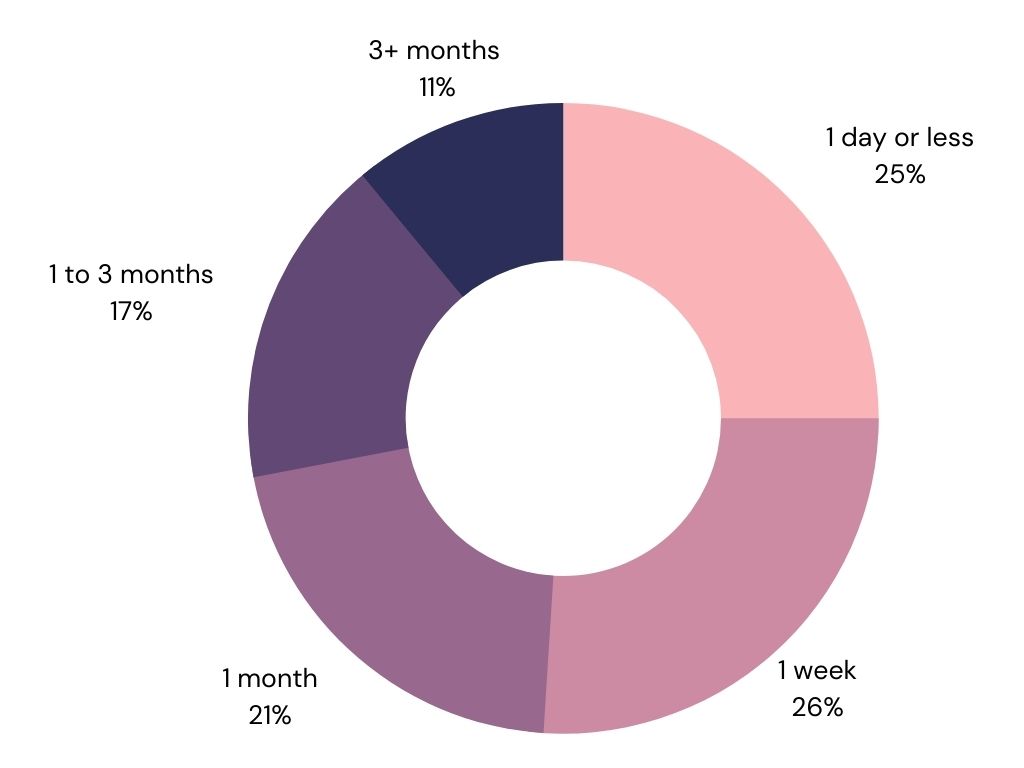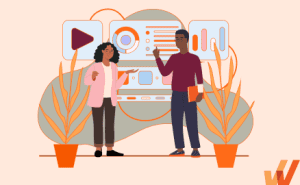How Long Should Onboarding Take? The Argument for Longer


For organizations investing in new talent, an effective employee onboarding process provides a framework to turn new hires into high-performers.
Employee onboarding provides support for new hires to get up-to-speed on your organization’s policies and processes, socially integrate into company culture, and set them up for long-lasting success.
What Is the Average Onboarding Time for New Employee?
For most technology and enterprise companies, the standard onboarding time for new employees is 90 days. However, most companies’ onboarding process is much shorter, according to CareerBuilder research.
Across 2,300+ HR professionals, 72% said the length of their employee onboarding time is less than one month. Even more staggering, 51% said it was one week or less.

How Long Should Employee Onboarding Take?
Employee onboarding is more than a one-time event. It’s an ongoing process that should support your new team members to feel confident that they’re equipped with the knowledge to effectively do their job, as well as welcomed by the company.
That’s why we advocate for organizations to create an employee onboarding process that lasts an entire year – something that only 2% of new companies are currently doing.
By extending onboarding out over an entire year, it allows HR teams to transition from a traditional employee onboarding strategy into a continuous learning & development strategy for new hires.
It’s important to remember that not all companies will require the same amount of onboarding time – some will require longer, and some will require less. The same type of thinking should be applied for various roles inside a company.
For example, a SaaS company has two new hires starting on the same day. One is a new business development rep (BDR) and the other is a new product marker. The BDR will need to learn various sales processes and call scripts. The product marketer will need to research and understand the buyer persona and value proposition of a product.
What Are the Arguments for a Longer Employee Onboarding Process?
Why does a longer onboarding process lead to new employees being more successful? It’s a combination of many factors, but here are the most important reasons why your organization should spend more time in the employee onboarding phase.
1. More comprehensive onboarding
A longer onboarding timeline allows for new employees to not feel pressured to become highly productive right away.
When new hires feel pressure to start performing right away, they can lose confidence, adopt bad habits or practices, cut corners, ultimately leading to an underperforming employee with low job satisfaction.
By thinking of employee onboarding as a longer process, HR teams and department-specific managers can invest in a ‘t-shape skill’ training strategy for their employees to teach them various, niche skill sets inside their specialized fields. The longer time also allows organizations to invest in social onboarding to acclimate new hires with their new team members.
Even with a longer onboarding cycle, a more comprehensive new hire onboarding process will ultimately reduce time-to-proficiency and create more well-rounded, effective employees.
2. Better knowledge retention
Starting a new role at a new company is knowledge overload. Research from Goins & Fisher revealed that without positive reinforcement, new hires will only retain 10% of what they’ve learned during onboarding after just 30 days on the job.
Additional research revealed that 70% of a new hires knowledge comes from knowledge they acquired from on-the-job training. This means that organizations must combine new ideas being introduced in onboarding and put it into practice as soon as possible – helping to form a link between the conceptual idea and the physical art of practice.
A longer onboarding process gives L&D teams, and department managers, the ability to introduce new ideas to new hires, give them time to put those ideas into practice, and then provide them with real-time training, in the moment of need, to help reinforce quality, productive habits.
3. Improves employee retention
Onboarding is the key to reducing turnover. According to a report from Workology, 1 in every 3 new hires will start searching for a new job within six months. 23% of those who began looking for a new job within six months said that a lack of clear job responsibilities and guidelines was their number one reason for leaving.
A better, longer onboarding timeline will give employees a better understanding of the “what” and “why” behind their job requirements and expectations and will help HR teams improve their employee retention rates during one of the toughest talent acquisition markets that have ever existed.
4. Supports employees by learning in the flow of work
HR departments have begun to look at onboarding as less of a transactional process (ie. filling out paperwork, creating application accounts, completely compliance training), and more of a continuous employee performance support process.
By extending the onboarding length, L&D teams are able to implement slow, integrated training directly into an employee’s day-to-day.
With training technologies such as a digital adoption platform like Whatfix, organizations are able to create step-by-step guided tutorials to embed directly into their digital applications and processes.

Imagine, instead of having an in-person Salesforce training session, you create a self-help knowledge base with answers to commonly asked questions and equipped with guided walkthroughs and tooltips that showcase how to complete various actions inside the CRM. This contextual onboarding content can be accessed at any time, inside your applications, empowering employees to learn in the flow of work.
5. Promotes a culture of continuous learning
Post-COVID, organizations are heavily investing in their L&D strategies – speificially to help reskill and upskill their workforce as rapid digital transformation occurs across roles and industries.
A longer onboarding process allows companies to get new hires acclimated to a culture of continuous learning, built into their job responsibilities from day one. This allows for companies to have a culture of knowledge sharing and continuous learning – driving innovation and growth for both individual employees and the company as a whole.
6. Drives company success
At the end of the day, ROI is the most important metric for any investment, even in talent acquisition and management.
According to the Boston Consulting Group, companies with great onboarding programs grow revenue 2.5x faster and have 1.9x better profit margins, in comparison to organizations with poor employee onboarding processes.
Investing in longer employee onboarding allows companies to shape how their new employees work on a day-to-day basis. It allows organizations to support their new investments with better resources and performance support.
This onboarding planning toolkit includes four free templates for creating and improving a robust employee onboarding program.
✓ Thank you, the checklist will be sent to your email
A longer onboarding process just makes more sense. With Whatfix, L&D teams are empowered to build in-app guided content that helps guide and teach new hires how to use digital tools and processes, as well as provide on-demand support with embedded FAQs and internal wikis.
Learn more about Whatfix for employee onboarding now!
Request a demo to see how Whatfix empowers organizations to improve end-user adoption and provide on-demand customer support


